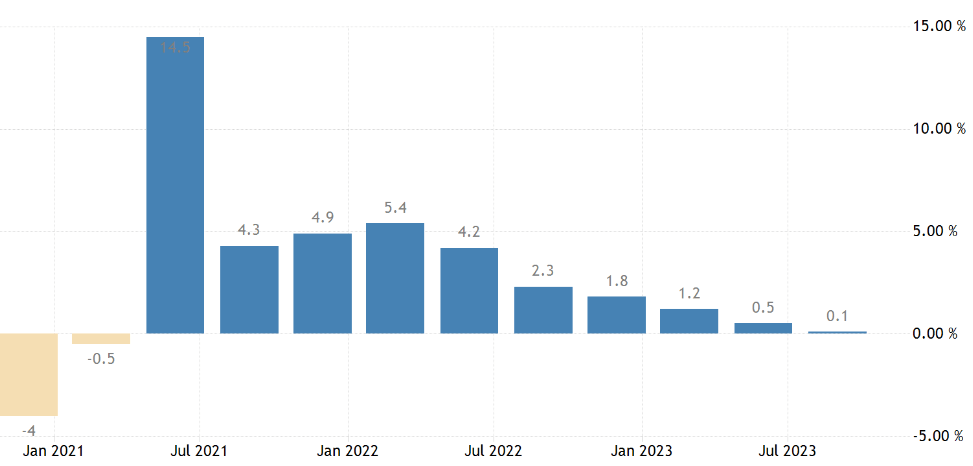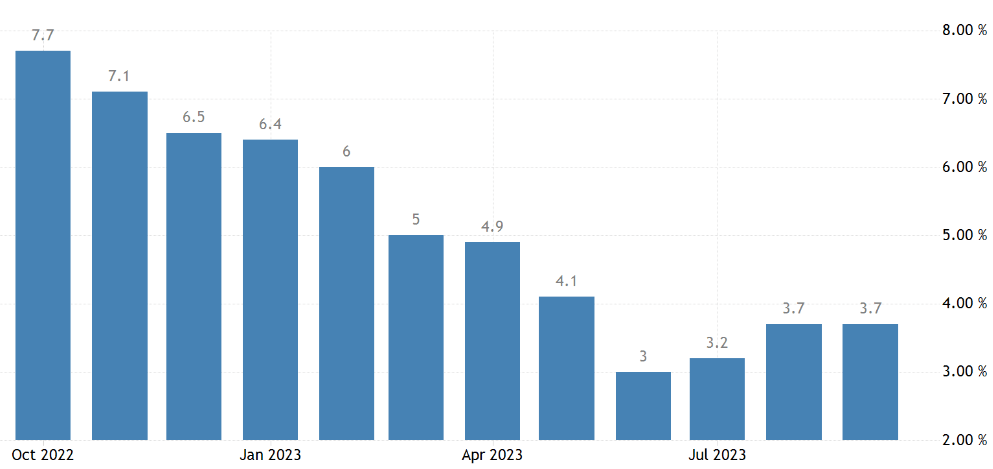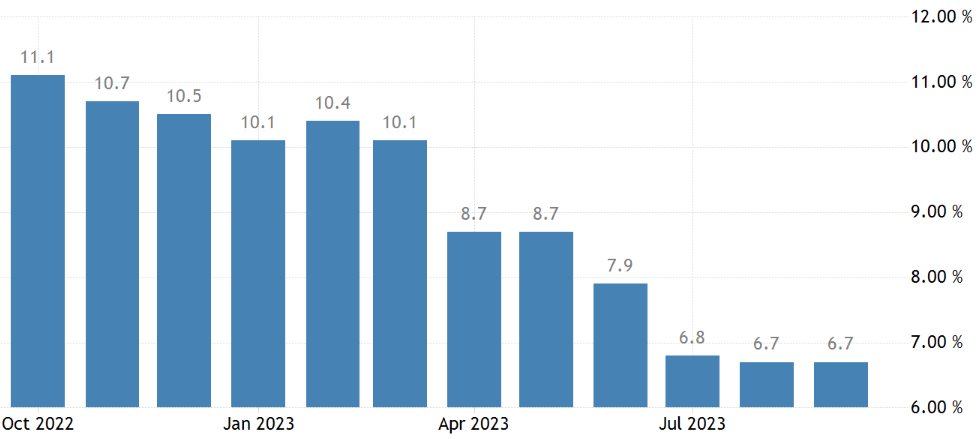As mid-November approaches, more and more companies with their financial year's third quarter ending in October report their quarterly earnings. Meanwhile, among other macroeconomic news, all three major economies – the US, the UK, and the Eurozone will report their inflation data for October.
Table of contents:
- Eurozone Gross Domestic Product (GDP) YoY (Q3)
- US Consumer Price Index (CPI) YoY (October)
- UK Consumer Price Index (CPI) YoY (October)
- Euro Area Consumer Price Index (CPI) YoY (October)
- Stocks to watch
Tuesday 14.11. 10:00 GMT, Eurozone Gross Domestic Product (GDP) YoY (Q3)
Gross domestic product (GDP) indicates the total value of goods and services produced in a country for a certain period. GDP is an important indicator of the health of an economy because it gives an overall picture of how well or poorly it is doing. If the GDP growth is higher than expected, the economy is in good shape and growing faster than expected. On the other hand, if the GDP growth is lower than expected, the economy performs weaker than anticipated. Furthermore, if the GDP growth is negative for two consecutive quarters, it may be considered a technical recession due to contracting economic output.
According to initial estimates, eurozone GDP grew by a modest 0.1% in the third quarter compared with the same period a year earlier, marking its weakest performance since the economic contraction experienced in 2021. This figure fell short of the anticipated 0.2% growth, as indicated by preliminary data. The average GDP annual growth rate in the Eurozone stood at 1.58% from 1995 to 2023. This metric reached its peak at 14.50% in the second quarter of 2021 and hit a historical low of -14.20% in the second quarter of 2020.

Source: Tradingeconomics.com
A higher-than-expected reading may have a bullish effect on the EUR, while a lower-than-expected reading could be bearish for the EUR.
Impact: EUR
Tuesday 14.11. 13:30 GMT, US Consumer Price Index (CPI) YoY (October)
The Consumer Price Index (CPI) is a tool used to monitor changes in the prices of goods and services that consumers buy. The CPI is an important indicator because it helps us understand the trends in consumer purchases and how inflation affects their purchasing power. The CPI is calculated based on a basket of goods and services representing typical consumer spending. It includes various categories such as food, housing, transportation, health care, etc. Regular measurements of the CPI allow us to track how the prices of these products and services change over time. A positive CPI indicates an overall increase in the prices of goods and services.
On the other hand, a negative CPI means that prices are lower than the year before. By analysing its changes, economists and policymakers may assess the impact of inflation on the economy and take appropriate action. The CPI also matters to consumers because it helps them understand how their money is losing value in the context of rising or falling prices. This information allows them to adjust their spending, plan savings, or make other financial decisions.
In September 2023, the US CPI held steady at 3.7%, contrary to market expectations of a slight dip to 3.6%. This stability was achieved due to a milder decline in energy prices, which offset the deceleration in inflation across other categories. Energy costs fell by 0.5%, following a fall of 3.6% in August, mainly due to a rebound in fuel prices. Additionally, the rates of price increases moderated in various sectors: food (3.7% versus 4.3%), new vehicles (2.5% versus 2.9%), apparel (2.3% versus 3.1%), medical care commodities (4.2% versus 4.5%), shelter (7.2% versus 7.3%), and transportation services (9.1% versus 10.3%). However, costs for used cars and trucks, as well as medical care services, continued to decline.
The core CPI, which excludes the volatile components of food and energy prices, slowed to 4.1%, marking its lowest level since September 2021. On a monthly basis, consumer prices increased by 0.4%, a slight deceleration from the 0.6% gain seen in August but surpassing market expectations of 0.3%. Meanwhile, the core rate remained unchanged at 0.3%. According to Trading Economics forecasts, a slight increase to 3.8% may be expected in the upcoming US CPI reading.

Source: Tradingeconomics.com
On the one hand, if the reading is higher than expected, it means higher inflation, favouring a fall in the USD. On the other hand, it is an incentive for the Fed to raise interest rates and reduce the money supply. From that point of view, it could suggest a rise in the USD value. However, if the reading is lower than expected, it would mean lower inflation, but it could give the Fed an argument to cut interest rates and increase the money supply.
Impact: USD
Wednesday 15.11. 07:00 GMT, UK Consumer Price Index (CPI) YoY (October)
In the UK, inflation has been almost twice as high as in the US in recent months. In September, UK inflation was unchanged at 6.7%, the same level as the 18-month low recorded in August. However, this defied market expectations of a small decline to 6.6%. The stability in inflation was due to less pronounced price increases in categories such as food and non-alcoholic beverages (12.1% compared to 13.6% in August) and furniture and household goods (3.7% compared to 5.1%). These mitigating factors were counterbalanced by a smaller decrease in energy costs (-0.2% compared to -3.2%), driven by a monthly upturn in motor fuel prices.
Core inflation, which strips out volatile elements such as energy and food, fell to 6.1%, the lowest since January but slightly above the expected 6%. It's important to note that both figures remain well above the Bank of England's 2% target, underlining the country's growing inflationary pressures. This poses a challenge for policymakers, who are expected to maintain interest rates at their current levels in the upcoming meeting. On a monthly basis, the Consumer Price Index (CPI) increased by 0.5% in September, marking the most substantial rise since May.

Source: Tradingeconomics.com
On the one hand, if the reading is higher than expected, it means higher inflation, favouring a fall in the GBP. On the other hand, it may be an incentive for the BoE to raise interest rates and reduce the money supply. From that point of view, it could suggest a rise in the GBP value. However, if the reading is lower than expected, it would mean lower inflation, but it could give the BoE an argument to cut interest rates and increase the money supply.
Impact: GBP
Friday 17.11. 10:00 GMT, Euro Area Consumer Price Index (CPI) YoY (October)
According to the initial estimates, October's inflation rate in the Eurozone is expected to be 2.9% year-on-year, marking its lowest point since July 2021 and slightly undershooting the market's consensus of 3.1%. Simultaneously, the core inflation rate, which excludes the impact of volatile food and energy prices, also moderated to 4.2% in October, reaching its lowest level since July 2022. It is worth noting that both rates have significantly approached the European Central Bank's target of 2% and are below those of the US and the UK.
Energy costs saw a significant decline of 11.1% (compared to -4.6% in September), and the inflation rates for food, alcohol, and tobacco (7.5% compared to 8.8%), as well as non-energy industrial goods (3.5% compared to 4.1%), eased. In contrast, services inflation remained relatively stable at 4.6%, compared to 4.7% in the preceding month. On a monthly basis, consumer prices inched up by 0.1% in October, following a 0.3% increase in September.

Source: Tradingeconomics.com
On the one hand, if the reading is higher than expected, it means higher inflation, favouring a fall in the EUR. On the other hand, it may be an incentive for the ECB to raise interest rates and reduce the money supply. From that point of view, it could suggest a rise in the EUR value. However, if the reading is lower than expected, it would mean lower inflation, but it could give the ECB an argument to cut interest rates and increase the money supply.
Impact: EUR
Stocks to watch
Home Depot (HD) announcing its earnings results for the quarter ending on 10/2023. Forecast EPS: 3.8. Positive earnings surprise in 9 out of the last 10 reports. Time: Tuesday, November 14, before the market opens.
Cisco (CSCO) announcing its earnings results for the quarter ending on 10/2023. Forecast EPS: 1.03. Positive earnings surprise in 10 out of the last 10 reports. Time: Wednesday, November 15, after the market closes.
Target (TGT) announcing its earnings results for the quarter ending on 10/2023. Forecast EPS: 1.47. Positive earnings surprise in 7 out of the last 10 reports. Time: Wednesday, November 15, before the market opens.
Walmart (WMT) announcing its earnings results for the quarter ending on 10/2023. Forecast EPS: 1.5. Positive earnings surprise in 9 out of the last 10 reports. Time: Thursday, November 16, before the market opens.
Applied Materials (AMAT) announcing its earnings results for the quarter ending on 10/2023. Forecast EPS: 1.99. Positive earnings surprise in 8 out of the last 10 reports. Time: Thursday, November 16, after the market closes.
Santa Zvaigzne-Sproge, CFA, Head of Investment Advice Department at Conotoxia Ltd. (Conotoxia investment service)
Materials, analysis, and opinions contained, referenced, or provided herein are intended solely for informational and educational purposes. The personal opinion of the author does not represent and should not be constructed as a statement, or investment advice made by Conotoxia Ltd. All indiscriminate reliance on illustrative or informational materials may lead to losses. Past performance is not a reliable indicator of future results.
CFDs are complex instruments and come with a high risk of losing money rapidly due to leverage. 72.95% of retail investor accounts lose money when trading CFDs with this provider. You should consider whether you understand how CFDs work and whether you can afford to take the high risk of losing your money.


